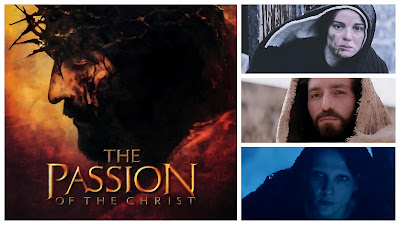“I am he.”
This month marks the 20th anniversary of Mel Gibson’s THE PASSION OF THE CHRIST.
Often considered to be one of the most controversial films of all time, THE PASSION OF THE CHRIST was a box office smash for 2004. It was brought to the screen by actor-turned-director Mel Gibson, who was coming off a string of acclaimed films including the Oscar-winning BRAVEHEART (1995), and THE MAN WITHOUT A FACE (1993). The independently produced film covered the final 12 hours before the death of Jesus Christ by crucifixion, including iconic Biblical happenings such as the Agony in the Garden, the Scourging at the Pillar, and his eventual resurrection.
Gibson co-wrote the script with screenwriter Benedict Fitzgerald, drawing on the gospels of Matthew, Mark, Luke, and John…along with other devotional writings and pious accounts. The film also drew from other parts of the New Testament.
The role of Jesus Christ was carried by Jim Caviezel. He was joined by Maia Morgenstern as Mary, the Mother of Jesus, and Monica Bellucci as Mary Magdalene. Italian actress Rosalinda Celentano played Satan. Filming took place in Italy and Rome, with the production re-using sets constructed for Martin Scorsese’s GANGS OF NEW YORK (2002). Dialogue was reconstructed in Aramaic, Hebrew, and Latin. John Debney provided the score.
Despite mixed reviews, THE PASSION was a box office hit, finishing the year as the 5th highest earner worldwide. Today it stands as the highest-grossing Christian film of all time, and the highest grossing independent film of all time. At the 77th Academy Awards, it would be nominated for three Oscars: Best Cinematography, Makeup, and Original Score. The People’s Choice Awards would name it Best Drama, and John Debney would win an ASCAP award.
*
Today, THE PASSION OF THE CHRIST is as controversial as it was 20 years ago. It’s brutal and uncompromising depictions of the flogging, beating, and crucifixion of Christ has made for cries of “torture porn” or even antisemitic. Gibson himself has admitted he went too far in places, even releasing a re-edited version of the film in theatres in 2005 with less violence. But the original version, blood and guts and all, makes the passion out as what it should be: ugly. It was a far cry from the glorified depictions of the crucifixion seen on stained glass windows and artwork, and maybe that’s why it was so shocking.
The film has its many enemies, but it also has its friends. Famed critic Roger Ebert defended the violence, and other critics and audiences regarded the film as a religious experience. Gibson and his cinematographer make art out of the ugliness; the stations of the cross are filmed in ways that look like paintings, and John Debney’s score is very moving. Underneath it all, Gibson also finds a story between mother and son, giving the film a palpable emotional hook. And the idea to cast a woman as Satan, because the devil is seductive, is a touch of genius.
This Blogger was working as a projectionist in the winter of 2004, taking a shift on a Sunday morning. During that winter, every Sunday afternoon would be met by busloads of church groups coming to see the film. They came not bearing crosses, but bearing a curiosity to see their icon on the big screen, brought to them by a director who fears no one…even to a fault. And when they left, many were in tears, weeping as if they had just seen the death of a loved one. It was raw power that only celluloid could deliver. If the mission of THE PASSION OF THE CHRIST was to move people in mysterious ways, then Mel Gibson nailed it.
“He was wounded for our transgressions, crushed for our iniquities; by His wounds are we healed.”


No comments:
Post a Comment
A few rules:
1. Personal attacks not tolerated.
2. Haters welcome, if you can justify it.
3. Swearing is goddamn OK.